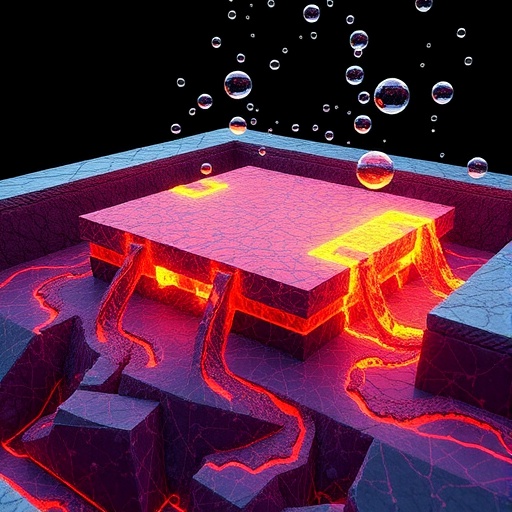In the ever-elusive depths beneath Earth’s crust, molten magma churns with a complex mixture of crystals and gas bubbles, a chaotic blend that has long challenged scientists seeking to decode the subtle messages carried by seismic waves. Now, a groundbreaking study originating from Tsukuba, Japan, unveils a sophisticated mathematical framework that elucidates how these microscopic components within magma influence the propagation of P-waves—primary seismic waves essential for probing Earth’s hidden volcanic chambers. This advancement promises to sharpen the predictive power of volcanic eruption models by translating seismic data into concrete insights about magma’s inner composition.
Seismic P-waves, the fastest type of elastic waves traveling through Earth’s interior, act as vital informants for volcanologists. Their speed and waveform carry encoded signatures of the physical state of the magma they traverse, including its crystal and gas bubble content. Despite the central role these signatures play, standard analytical models have historically emphasized the effects of gas bubbles on wave velocity and amplitude attenuation, often neglecting the intricate interplay with crystal particles embedded in the melt. This omission has left a critical gap in our understanding of how seismic waves deform and dissipate energy as they venture through this heterogeneous medium.
Addressing this deficiency, the research team crafted a novel equation born from the synthesis of two distinct mathematical models describing magma flow dynamics. These models individually capture facets of magma’s rheology and deformation behavior; their integration enables a unified description that accounts for both bubble-rich and crystal-laden scenarios. The resulting equation skillfully characterizes the weakly nonlinear propagation of P-waves, thereby accommodating subtle alterations in waveform shape and energy attenuation otherwise overlooked in linear approximations.
One of the study’s pivotal findings is the nuanced relationship between the concentrations of gas bubbles and crystals and their differential effects on seismic waves. As bubbles increase relative to crystals, the velocity of P-waves diminishes significantly, a consequence of increased compressibility and scattering within the bubbly magma. Contrastingly, the presence of crystals exerts a stronger influence on wave attenuation rather than on velocity reduction. This demonstrates that crystals primarily undermine wave energy by converting it into internal friction and heat, which alters the amplitude decay patterns observed on seismic records.
The investigation further reveals that the evolving waveform characteristics are frequency-dependent, highlighting the complex dispersive nature of wave propagation through magma. Higher-frequency components are more sensitive to changes in bubble content, resulting in distinct waveform distortions that can be exploited as diagnostic indicators. Furthermore, these frequency-dependent effects differ between the two foundational magma flow models, implying that natural variability in magma rheology can yield markedly divergent seismic signatures.
By enabling time-domain calculations of P-waveforms rooted explicitly in magma composition, this new mathematical paradigm transcends prior models limited to aggregate parameters such as velocity and attenuation coefficients. It offers a pathway to simulate realistic seismic waveforms that reflect the dynamic interplay of gas bubbles and crystals within subterranean magma reservoirs. This capability is crucial because the internal structure of these reservoirs governs volcanic eruption dynamics, yet remains largely inaccessible to direct measurement.
Looking forward, the researchers envision coupling their robust physical model with advanced machine learning algorithms. This integrated approach aspires to invert observed seismic waveforms back into estimates of earthquake-inducing magma compositions with unprecedented fidelity. Such data-driven inference could revolutionize volcanic hazard assessment by generating more accurate, real-time predictions that better inform evacuation protocols and risk mitigation efforts.
The importance of this development extends beyond volcanology. Understanding nonlinear wave propagation in multiphase fluids-—here exemplified by magma—offers insights into a broad class of geophysical and industrial processes. From earthquake seismology to energy extraction and material manufacturing, the principles uncovered by this study provide a conceptual scaffold to address wave behavior in complex, heterogeneous media.
The collaborative endeavor was nurtured by support from Japan Society for the Promotion of Science (JSPS) KAKENHI, the Keirin Racing Association, and several research grants administered by Japanese national energy and technology development organizations. The blend of public and private funding illustrates the growing recognition of fundamental geophysical research’s value in safeguarding societies vulnerable to natural disasters.
Moreover, the publication of this study in the prestigious journal Physics of Fluids underscores its technical rigor and relevance to both fluid mechanics and earth sciences communities. The work pioneers a nuanced appreciation of how microscopic phase distribution affects macroscopic wave dynamics—a theme that resonates across fluid dynamics, rheology, and wave theory disciplines.
Crucially, the unveiling of this new wave propagation equation arrives at a moment when monitoring volcanic activity has never been more vital. Worldwide, increased seismic activity and climatic shifts intensify the urgency to comprehend and anticipate volcanic hazards. This model enriches the toolkit available to volcanologists, enabling deeper interpretation of seismic signals that herald eruptions.
To distill, this study represents a leap forward in demystifying the subtle signatures embedded in seismic waves as they traverse bubbly and crystal-bearing magma. By mathematically decoding these effects, researchers edge closer to peering inside Earth’s fiery veins with clarity that was previously unattainable. The potential to harness these insights for predictive eruption models carries promises of enhanced safety and resilience for populations living in the shadow of volcanoes.
Ultimately, this work exemplifies the fusion of theoretical physics, applied mathematics, and geoscience to illuminate one of nature’s most turbulent processes. It serves as a testament to the power of interdisciplinary collaboration and meticulous modeling to transform raw seismic vibrations into actionable intelligence about Earth’s volatile interior.
Subject of Research: Seismic P-wave propagation in multiphase magma containing crystals and gas bubbles
Article Title: Weakly nonlinear wave propagation in magma containing crystals and bubbles
News Publication Date: April 9, 2025
Web References:
Physics of Fluids Article
Institute of Systems and Information Engineering, University of Tsukuba
References:
Kanagawa, T., et al. (2025). Weakly nonlinear wave propagation in magma containing crystals and bubbles. Physics of Fluids. DOI: 10.1063/5.0251612
Keywords: Magma, Volcanology, Seismic P-waves, Gas bubbles, Crystals, Nonlinear wave propagation, Attenuation, Rheology, Waveform analysis, Volcano eruption prediction, Fluid mechanics, Earthquakes




